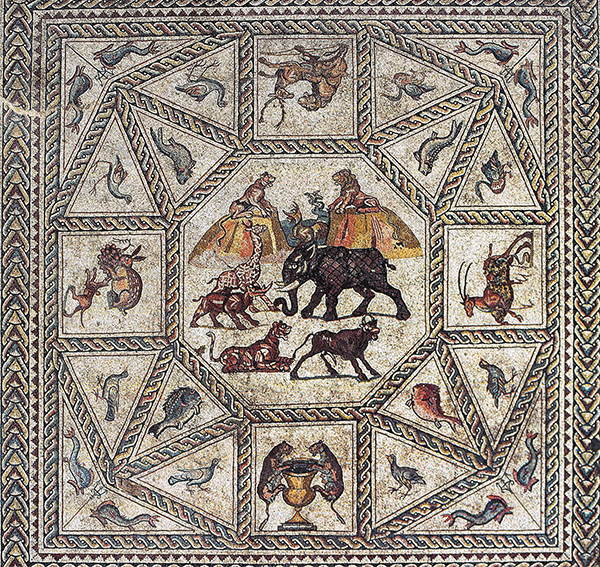
It is the largest—and surely one of the most beautiful—mosaics ever discovered in Israel.
An inspector from the Israel Antiquities Authority discovered it on a routine inspection of a real estate maintenance and construction project; these inspectors make sure that antiquities are not destroyed in the course of real estate and road development. Israel has 30,000 antiquities sites discovered so far. Sites often surface during development work and can be destroyed if not protected.
The mosaic was exposed about 3 feet below ground in what was probably the main reception hall or dining room (triclinium) of an elegant house or manor of the late third or fourth century C.E. in the city of Lod.1 Called Diospolis at the time, Lod was once an important Roman city on the Via Maris, the Way of the Sea, that ran along the coast of Palestine leading from Egypt to Syria.
Several mosaics have been found at Lod, the three most recent fully excavated only in 2014 (one of which is featured on the cover). But nothing can match the eye-popping mosaic initially discovered in 1996—popularly called the Lod Mosaic, singular.
The main Lod Mosaic is 56 feet long and 30 feet wide. It contains stone and glass tesserae (small square tiles) of nearly 30 different colors. Two different sections are separated by a mosaic strip extending beyond the north and south sides of the mosaic. This mosaic strip features a krater with extended vines.
The mosaic carpets north and south of this strip are themselves each divided into parts. The mosaic carpet south of the strip consists of two panels—one featuring birds and the other geometric spaces with birds, fish and animals.

The mosaic carpet north of the strip consists of three panels. The lowest one pictures all kinds of fish and two ships. The middle panel consists of a central octagon portraying a lion and a lioness on two separate mountaintops protecting the entrance from an outer sea into a charmed space that includes a giraffe, rhinoceros, elephant, tiger and bull. A sea monster frolics in the water between the two mountains.

Glen Bowersock, Professor Emeritus of Ancient History at the Institute for Advanced Study in Princeton, has suggested that the space protected by the lions on the mountaintops might represent the peaceable kingdom of Isaiah. He points to another mosaic portraying animals, who normally confront each other antagonistically, facing each other peaceably; that mosaic actually contains an inscription from Isaiah—the wolf will live with the lamb, etc. (Isaiah 11:6–7).2 Does this begin to suggest the identity of the mosaic’s owner?
The first thing that is likely to strike BAR readers is the complete absence of any human figures. In an elegant book on the Lod mosaics published in 2015 by the Israel Antiquities Authority and Scala Arts Publishers,3 two scholars, Rina Talgam of Hebrew University and Zaraza Friedman, an independent Israeli scholar, both raise the question as to whether this somewhat surprising absence of human figures indicates that this Roman villa in Lod was owned by Jews—or possibly by Christians—rather than by pagan Romans.
Bowersock notes that the elephant, tiger and giraffe often accompany Dionysos, the god of wine and fertility, in Roman mosaics, but he is not pictured here. Does this also suggest the religion of the owner of the villa?
Lod was a multiethnic city at the time, so the possibilities, at least theoretically, are many. While the Jewish community was the largest, the population also included Christians and pagans and possibly Samaritans. The mosaic contains no inscriptions, and the finds from the excavation do not indicate the identity of the mosaic’s owner.
The absence of human figures is emphasized by the presence of ships. Ship mosaics usually include at least some evidence of seafarers. But not these ships, as if whoever commissioned this mosaic had some aversion to depicting the sailors.


Talgam points to one possible objection to the suggestion that the mosaic was commissioned by a Jew: One of the ships in the mosaic features a cross on the prow! But this is not a usual Christian cross. It is difficult to tell what it is or what it’s doing there.
Whoever the owners were, they lived an affluent and luxurious lifestyle. Colored frescoes as well as marble and stucco fragments were recovered from this extravagant building.
Because of its exceptional beauty, the Lod Mosaic was lifted and removed for conservation. Once conserved, it was “movable,” so to speak, and it has gone on a worldwide tour—to the Metropolitan Museum in New York, the Field Museum in Chicago, the Louvre in Paris, the Altes Museum in Berlin, the Hermitage in St. Petersburg and elsewhere. Its ultimate home, however, will be the Shelby White and Leon Levy Lod Mosaic Archaeological Center in Lod, Israel
MLA Citation
Endnotes
1. The initial excavation was directed by Miriam Avissar of the Israel Antiquities Authority (IAA). She was later joined by Amir Gorzalczany, also of the IAA.
2. See Glen Bowersock, “Introduction,” in Israel Antiquities Authority, ed., The Lod Mosaic: A Spectacular Roman Mosaic Floor (New York: Scala Arts Publishers, Inc., 2015), p. 17.
3. Israel Antiquities Authority, ed., The Lod Mosaic: A Spectacular Roman Mosaic Floor (New York: Scala Arts Publishers, Inc., 2015).

